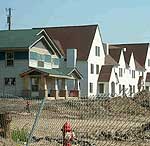By Brandt Williams
Minnesota Public Radio
July 16, 2002
A University of Minnesota researcher says the Minneapolis Public Housing Authority's plan to reduce the concentration of poverty in an area of the city's north side has had mixed results. Edward Goetz recently completed a three-year study on the dispersal of more than 400 families out of a public housing project and into the metro area. He says the relocation has helped many families move to nicer neighborhoods, but he says overall it hasn't helped the families improve their financial situations. Minneapolis housing officials say Goetz's report is misleading.
| |
|
|
|
||
In 1995, a settlement was reached in a class-action lawsuit against city and federal housing agencies over the concentration of poor people living in a 73-acre housing project in north Minneapolis. The settlement called for the dispersal of the families living in the public housing projects, and the demolition and redevelopment of the area.
In 1998, the University of Minnesota's Center for Urban and Regional Affairs received a grant from the Family Housing Fund to study the implementation of the so-called Hollman Decree. University research associate Edward Goetz led the effort. He says most families believed they moved to a nicer area than the one they left.
"So they felt good about that. There are mixed findings on other items. They don't report any changes in their level of social interaction, no differences in their children's school experiences, and less of a change in the satisfaction of the neighborhoods than I would expect," Goetz says.
The report also shows that the relocated residents weren't more likely to be employed, have higher wages, or have greater opportunity to get promoted in their jobs than before they moved.
Goetz says the study is significant because it's the first of its kind in the nation to compare the merits of voluntary versus involuntary relocation efforts in one area. He says the data show that residents who volunteered to move to replacement housing report having more favorable experiences than those forced to move. However, he says even those who moved voluntarily didn't enjoy the kind of benefits as people in similar situations in other large cities.
"To a large extent, the conditions on the north side of Minneapolis weren't as bad as the worst of the public housing in Baltimore and Chicago," says Goetz.
"This whole program is not about relocation," says Cora McCorvey, executive director of the Minneapolis Public Housing Authority.
| |
|
|
|
||
McCorvey says the report pays too much attention to relocation - which she says is just a small part of the consent decree.
"It was about providing people with choice. It was about providing a greater range of housing opportunities in various locations for poor people," McCorvey says.
The study shows that 10 percent of the relocated residents chose to live in replacement housing located in the suburbs - and that nearly 60 percent chose to live within a three-mile radius of their former neighborhood. McCorvey says that's because so many people wanted to live near their families, churches and accessible public transportation.
One of the groups which represented the plaintiffs in the lawsuit believes the consent decree has more to do with choice than relocation. Tim Thompson is with the Legal Aid Society of Minneapolis. In 1992, the Legal Aid Society filed the suit against the MPHA and U.S. Department of Housing and Urban Development. Thompson says now relocated residents can live where they want - but he says choices were more limited in the early years of the relocation program.
"That happened several years ago, at a time in which the housing authority's opportunities to get them a lot of choices were really limited. They had Section 8, which was very difficult to use, because the market was so tight and the public housing replacement units had not been built," says Johnson.
This fall the MPHA expects about 45 units of new housing to open up at Heritage Park, the area where the old public housing units once stood. McCorvey says 16 of those units will be reserved for low-income families who were relocated and want to return to the area.
MPR's Dan Olson contributed to this report
More Information

